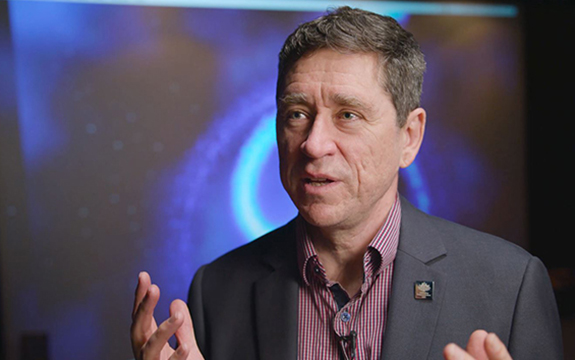New ARC Centre of Excellence for Gravitational Wave Discovery announced

In Summary
- $31.3 million ARC Centre of Excellence for Gravitational Wave Discovery
- Led by Swinburne University of Technology
- The Centre will be called OzGRav
- Professor Matthew Bailes announced as Director
- Centre opens early 2017
The Australian Research Council (ARC) today announced a new $31.3 million ARC Centre of Excellence for Gravitational Wave Discovery to be led by Swinburne University of Technology.
The Centre, to be called OzGRav, will capitalise on the first detections of gravitational waves to understand the extreme physics of black holes and warped space-time.
The discovery of gravitational waves
Gravitational waves were first predicted by Albert Einstein in 1915 in his theory of General Relativity, which described how gravity warps and distorts space-time.
Einstein's mathematics showed that massive accelerating objects (such as neutron stars or black holes orbiting each other) distort both space and time and emit a new type of radiation, known as gravitational waves.
These predicted gravitational waves are incredibly feeble. They went undetected for one hundred years until recent advances in detector sensitivity at the Advanced Laser Interferometer Gravitational-Wave Observatory (aLIGO) enabled their detection for the first time, opening a new window on the Universe.
In September 2015, aLIGO physically sensed distortions in space-time itself caused by passing gravitational waves generated by two colliding black holes nearly 1.3 billion light years away!
The arms of the detector changed their length by the equivalent of just the width of a human hair at the distance of the nearest star!
Expanding Australia's role in gravitational wave astronomy
Many of OZGRav’s chief investigators helped aLIGO achieve this amazing feat and are thrilled to be able to expand Australia’s role in this nascent field of science as a result of the ARC announcement.
“Through this centre, Australian scientists and students will have the opportunity to fully participate in the birth of gravitational wave astronomy,” says Centre Director and Professor Matthew Bailes.
“It will enable us to develop some amazing technologies like quantum squeezing to further enhance the detectors, supercomputers and advanced algorithms to find the waves, and these will lead to a revolution in our understanding of the Universe.”
This new window on the Universe will help answer key scientific questions such as:
- Is Einstein’s General Relativity correct when applied to the most extreme gravitational forces?
- What and where are the sources of gravitational waves?
- Do supermassive black holes merge often enough for us to see their death-cries with the Square Kilometre Array telescope?
- Can General Relativity be used to determine neutron star masses to help define the equation of state of nuclear matter?
It will also contribute to improving the sensitivity of aLIGO, thus increasing the volume of the Universe that can be probed by an order of magnitude and lay the ground work for future gravitational wave detectors that will probe the entire Universe.
Swinburne to host OzGRav headquarters
“The world stands at the dawn of a new field of astrophysics. A field that demands the most exquisite instrumentation, intense signal processing and rapid follow-up with modern telescopes, Swinburne Deputy Vice-Chancellor (Research and Development) Professor Subic says.
“As an internationally-renowned university of technology, with an exceptional physics base, there is no better place to host the headquarters of this exciting world-wide collaboration than at Swinburne.
“I am particularly pleased that the new centre will be led by our Australian Laureate Fellow, Professor Matthew Bailes.”
As part of its support for OzGRav, Swinburne will fund a new $3.5 million supercomputer in 2017. Up to 35 per cent of its time will be dedicated for gravitational wave searches.
“It would be fantastic to think that we might discover new sources of gravitational waves right here on campus”, says Professor Jarrod Hurley, who will design OzGRav’s supercomputer.
Part of the Centre’s mission is to capitalise on the public’s fascination with black holes to help spark an interest in science, technology, engineering and mathematics using school activities, social media and prominent science advocates such as Dr Alan Duffy and Olympic swimmer and physics student, Cameron McEvoy.
Australian partners in this Centre of Excellence are Monash University, Australian National University, the University of Melbourne, the University of Western Australia, The University of Adelaide, CSIRO, and the Australian Astronomical Observatory.
International partners include the LIGO Observatory, Caltech, the University of Florida, the University of Glasgow, the Max Planck Institutes of Gravitational Physics and Radio Astronomy, MIT, NASA, the University of Warwick and the Universita degli Studi di Urbino ‘Carlo Bo’.
The Centre will open in early 2017. Visit the OzGrav website.

